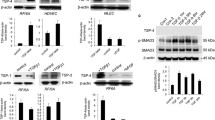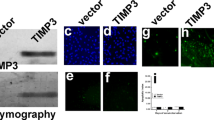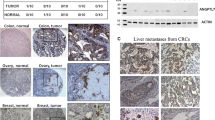Abstract
ADAMTS-2 is a metalloproteinase that plays a key role in the processing of fibrillar procollagen precursors into mature collagen molecules by excising the amino-propeptide. We demonstrate that recombinant ADAMTS-2 is also able to reduce proliferation of endothelial cells, and to induce their retraction and detachment from the substrate resulting in apoptosis. Dephosphorylation of Erk1/2 and MLC largely precedes the ADAMTS-2 induced morphological alterations. In 3-D culture models, ADAMTS-2 strongly reduced branching of capillary-like structures formed by endothelial cells and their long-term maintenance and inhibited vessels formation in embryoid bodies (EB). Growth and vascularization of tumors formed in nude mice by HEK 293-EBNA cells expressing ADAMTS-2 were drastically reduced. A similar anti-tumoral activity was observed when using cells expressing recombinant deleted forms of ADAMTS-2, including catalytically inactive enzyme. Nucleolin, a nuclear protein also found to be associated with the cell membrane, was identified as a potential receptor mediating the antiangiogenic properties of ADAMTS-2.












Similar content being viewed by others
Abbreviations
- EB:
-
Embryoid body
- EBM:
-
Endothelial basal medium
- ES cell:
-
Embryonic stem cell
- HEK 293-EBNA cell:
-
Human embryonic kidney 293-Epstein Barr nuclear antigen cell
- HMEC:
-
Human microvascular endothelial cell
- HMVEC:
-
Human dermal microvascular endothelial cell
- HSF:
-
Human skin fibroblasts
- HSMC:
-
Human smooth muscle cell
- HSPG::
-
Heparan sulfate proteoglycan
- HUVEC:
-
Human umbilical vein endothelial cell
- MLC:
-
Myosin light chain
- mTS2:
-
Catalytically inactive ADAMTS-2
- PAK:
-
p21 Activated kinase
- PECAM:
-
Platelet endothelial cell adhesion molecule: CD31
- ROCK:
-
Rho kinase
- TSR1:
-
Thrombospondin repeat type 1
- TS-2:
-
ADAMTS-2
- wtTS2:
-
Wild-type ADAMTS-2
References
Bix G, Iozzo RV (2005) Matrix revolutions: “tails” of basement-membrane components with angiostatic functions. Trends Cell Biol 15:52–60
Sottile J (2004) Regulation of angiogenesis by extracellular matrix. Biochim Biophys Acta 1654:13–22
Folkman J (1972) Anti-angiogenesis: new concept for therapy of solid tumors. Ann Surg 175:409–416
Armstrong LC, Bornstein P (2003) Thrombospondins 1 and 2 function as inhibitors of angiogenesis. Matrix Biol 22:63–71
Lee NV, Sato M, Annis DS, Loo JA, Wu L, Mosher DF, Iruela-Arispe ML (2006) ADAMTS1 mediates the release of antiangiogenic polypeptides from TSP1 and 2. EMBO J 25:5270–5283
Adams JC (2001) Thrombospondins: multifunctional regulators of cell interactions. Annu Rev Cell Dev Biol 17:25–51
Febbraio M, Hajjar DP, Silverstein RL (2001) CD36: a class B scavenger receptor involved in angiogenesis, atherosclerosis, inflammation, and lipid metabolism. J Clin Invest 108:785–791
Tolsma SS, Volpert OV, Good DJ, Frazier WA, Polverini PJ, Bouck N (1993) Peptides derived from two separate domains of the matrix protein thrombospondin-1 have anti-angiogenic activity. J Cell Biol 122:497–511
Grant MA, Kalluri R (2005) Structural basis for the functions of endogenous angiogenesis inhibitors. Cold Spring Harb Symp Quant Biol 70:399–410
O’Reilly MS, Holmgren L, Shing Y, Chen C, Rosenthal RA, Moses M, Lane WS, Cao Y, Sage EH, Folkman J (1994) Angiostatin: a novel angiogenesis inhibitor that mediates the suppression of metastases by a Lewis lung carcinoma. Cell 79:315–328
Wahl ML, Kenan DJ, Gonzalez-Gronow M, Pizzo SV (2005) Angiostatin’s molecular mechanism: aspects of specificity and regulation elucidated. J Cell Biochem 96:242–261
Heljasvaara R, Nyberg P, Luostarinen J, Parikka M, Heikkila P, Rehn M, Sorsa T, Salo T, Pihlajaniemi T (2005) Generation of biologically active endostatin fragments from human collagen XVIII by distinct matrix metalloproteases. Exp Cell Res 307:292–304
Luque A, Carpizo DR, Iruela-Arispe ML (2003) ADAMTS1/METH1 inhibits endothelial cell proliferation by direct binding and sequestration of VEGF165. J Biol Chem 278:23656–23665
Vazquez F, Hastings G, Ortega MA, Lane TF, Oikemus S, Lombardo M, Iruela-Arispe ML (1999) METH-1, a human ortholog of ADAMTS-1, and METH-2 are members of a new family of proteins with angio-inhibitory activity. J Biol Chem 274:23349–23357
Iruela-Arispe ML, Luque A, Lee N (2004) Thrombospondin modules and angiogenesis. Int J Biochem Cell Biol 36:1070–1078
Iruela-Arispe ML, Carpizo D, Luque A (2003) ADAMTS1: a matrix metalloprotease with angioinhibitory properties. Ann NY Acad Sci 995:183–190
Colige A, Beschin A, Samyn B, Goebels Y, Van Beeumen J, Nusgens BV, Lapiere CM (1995) Characterization and partial amino acid sequencing of a 107-kDa procollagen I N-proteinase purified by affinity chromatography on immobilized type XIV collagen. J Biol Chem 270:16724–16730
Colige A, Li SW, Sieron AL, Nusgens BV, Prockop DJ, Lapiere CM (1997) cDNA cloning and expression of bovine procollagen I N-proteinase: a new member of the superfamily of zinc-metalloproteinases with binding sites for cells and other matrix components. Proc Natl Acad Sci USA 94:2374–2379
Colige A, Ruggiero F, Vandenberghe I, Dubail J, Kesteloot F, Van Beeumen J, Beschin A, Brys L, Lapiere CM, Nusgens B (2005) Domains and maturation processes that regulate the activity of ADAMTS-2, a metalloproteinase cleaving the aminopropeptide of fibrillar procollagens types I–III and V. J Biol Chem 280:34397–34408
Colige A, Sieron AL, Li SW, Schwarze U, Petty E, Wertelecki W, Wilcox W, Krakow D, Cohn DH, Reardon W, Byers PH, Lapiere CM, Prockop DJ, Nusgens BV (1999) Human Ehlers-Danlos syndrome type VII C and bovine dermatosparaxis are caused by mutations in the procollagen I N-proteinase gene. Am J Hum Genet 65:308–317
Wang WM, Lee S, Steiglitz BM, Scott IC, Lebares CC, Allen ML, Brenner MC, Takahara K, Greenspan DS (2003) Transforming growth factor-beta induces secretion of activated ADAMTS-2. A procollagen III N-proteinase. J Biol Chem 278:19549–19557
Colige A, Nuytinck L, Hausser I, van Essen AJ, Thiry M, Herens C, Ades LC, Malfait F, Paepe AD, Franck P, Wolff G, Oosterwijk JC, Smitt JH, Lapiere CM, Nusgens BV (2004) Novel types of mutation responsible for the dermatosparactic type of Ehlers-Danlos syndrome (Type VIIC) and common polymorphisms in the ADAMTS2 gene. J Invest Dermatol 123:656–663
Li SW, Arita M, Fertala A, Bao Y, Kopen GC, Langsjo TK, Hyttinen MM, Helminen HJ, Prockop DJ (2001) Transgenic mice with inactive alleles for procollagen N-proteinase (ADAMTS-2) develop fragile skin and male sterility. Biochem J 355:271–278
Jaffe EA, Nachman RL, Becker CG, Minick CR (1973) Culture of human endothelial cells derived from umbilical veins. Identification by morphologic and immunologic criteria. J Clin Invest 52:2745–2756
Ades EW, Candal FJ, Swerlick RA, George VG, Summers S, Bosse DC, Lawley TJ (1992) HMEC-1: establishment of an immortalized human microvascular endothelial cell line. J Invest Dermatol 99:683–690
Colige AC, Lambert CA, Nusgens BV, Lapiere CM (1992) Effect of cell-cell and cell-matrix interactions on the response of fibroblasts to epidermal growth factor in vitro. Expression of collagen type I, collagenase, stromelysin and tissue inhibitor of metalloproteinases. Biochem J 285(Pt 1):215–221
Millette E, Rauch BH, Defawe O, Kenagy RD, Daum G, Clowes AW (2005) Platelet-derived growth factor-BB-induced human smooth muscle cell proliferation depends on basic FGF release and FGFR-1 activation. Circ Res 96:172–179
Labarca C, Paigen K (1980) A simple, rapid, and sensitive DNA assay procedure. Anal Biochem 102:344–352
Deroanne CF, Colige AC, Nusgens BV, Lapiere CM (1996) Modulation of expression and assembly of vinculin during in vitro fibrillar collagen-induced angiogenesis and its reversal. Exp Cell Res 224:215–223
Deroanne CF, Bonjean K, Servotte S, Devy L, Colige A, Clausse N, Blacher S, Verdin E, Foidart JM, Nusgens BV, Castronovo V (2002) Histone deacetylases inhibitors as anti-angiogenic agents altering vascular endothelial growth factor signaling. Oncogene 21:427–436
Tobe T, Ortega S, Luna JD, Ozaki H, Okamoto N, Derevjanik NL, Vinores SA, Basilico C, Campochiaro PA (1998) Targeted disruption of the FGF2 gene does not prevent choroidal neovascularization in a murine model. Am J Pathol 153:1641–1646
Hanahan D, Weinberg RA (2000) The hallmarks of cancer. Cell 100:57–70
Kerbel RS (1991) Inhibition of tumor angiogenesis as a strategy to circumvent acquired resistance to anti-cancer therapeutic agents. Bioessays 13:31–36
Kerbel RS (2008) Tumor angiogenesis. N Engl J Med 358:2039–2049
Noh YH, Matsuda K, Hong YK, Kunstfeld R, Riccardi L, Koch M, Oura H, Dadras SS, Streit M, Detmar M (2003) An N-terminal 80-kDa recombinant fragment of human thrombospondin-2 inhibits vascular endothelial growth factor induced endothelial cell migration in vitro and tumor growth and angiogenesis in vivo. J Invest Dermatol 121:1536–1543
Minambres R, Guasch RM, Perez-Arago A, Guerri C (2006) The RhoA/ROCK-I/MLC pathway is involved in the ethanol-induced apoptosis by anoikis in astrocytes. J Cell Sci 119:271–282
Llamazares M, Obaya AJ, Moncada-Pazos A, Heljasvaara R, Espada J, Lopez-Otin C, Cal S (2007) The ADAMTS12 metalloproteinase exhibits anti-tumorigenic properties through modulation of the Ras-dependent ERK signalling pathway. J Cell Sci 120:3544–3552
Grunewald FS, Prota AE, Giese A, Ballmer-Hofer K (2010) Structure-function analysis of VEGF receptor activation and the role of coreceptors in angiogenic signaling. Biochim Biophys Acta 1804:567–580
Kinsella MG, Irvin C, Reidy MA, Wight TN (2004) Removal of heparan sulfate by heparinase treatment inhibits FGF-2-dependent smooth muscle cell proliferation in injured rat carotid arteries. Atherosclerosis 175:51–57
Di Segni A, Farin K, Pinkas-Kramarski R (2008) Identification of nucleolin as new ErbB receptors-interacting protein. PLoS One 3:e2310
Srivastava M, Pollard HB (1999) Molecular dissection of nucleolin’s role in growth and cell proliferation: new insights. FASEB J 13:1911–1922
Christian S, Pilch J, Akerman ME, Porkka K, Laakkonen P, Ruoslahti E (2003) Nucleolin expressed at the cell surface is a marker of endothelial cells in angiogenic blood vessels. J Cell Biol 163:871–878
Shi H, Huang Y, Zhou H, Song X, Yuan S, Fu Y, Luo Y (2007) Nucleolin is a receptor that mediates antiangiogenic and antitumor activity of endostatin. Blood 110:2899–2906
Fogal V, Sugahara KN, Ruoslahti E, Christian S (2009) Cell surface nucleolin antagonist causes endothelial cell apoptosis and normalization of tumor vasculature. Angiogenesis 12:91–100
Destouches D, El Khoury D, Hamma-Kourbali Y, Krust B, Albanese P, Katsoris P, Guichard G, Briand JP, Courty J, Hovanessian AG (2008) Suppression of tumor growth and angiogenesis by a specific antagonist of the cell-surface expressed nucleolin. PLoS One 3:e2518
Lambert V, Wielockx B, Munaut C, Galopin C, Jost M, Itoh T, Werb Z, Baker A, Libert C, Krell HW, Foidart JM, Noel A, Rakic JM (2003) MMP-2 and MMP-9 synergize in promoting choroidal neovascularization. FASEB J 17:2290–2292
Mineur P, Colige AC, Deroanne CF, Dubail J, Kesteloot F, Habraken Y, Noel A, Voo S, Waltenberger J, Lapiere CM, Nusgens BV, Lambert CA (2007) Newly identified biologically active and proteolysis-resistant VEGF-A isoform VEGF111 is induced by genotoxic agents. J Cell Biol 179:1261–1273
Fushimi K, Troeberg L, Nakamura H, Lim NH, Nagase H (2008) Functional differences of the catalytic and non-catalytic domains in human ADAMTS-4 and ADAMTS-5 in aggrecanolytic activity. J Biol Chem 283:6706–6716
Karagiannis ED, Popel AS (2007) Anti-angiogenic peptides identified in thrombospondin type I domains. Biochem Biophys Res Commun 359:63–69
Acknowledgments
This work was supported by grants from the Belgian Fonds de la Recherche Scientifique Médicale (Grant nos. 3.4362.03 and 3.4387.05), the Belgian Fonds National de la Recherche Scientifique, the “Foundation against Cancer”, the “Fondation Léon Fredericq” (University of Liège), the “Centre Anticancéreux près l’Université de Liège” and the “Région Wallonne” (NeoAngio, grant no. 616476). We thank the “Proteomic” (M.-A. Meuwis) and “Imaging and Flow cytometry” (Sandra Ormenese) platforms of GIGA-R (University of Liège) and Dr. Prockop (Texas A&M Health Science Center, USA) for the kind gift of ADAMTS-2 −/− mice.
Author information
Authors and Affiliations
Corresponding author
Electronic supplementary material
Below is the link to the electronic supplementary material.
18_2010_431_MOESM1_ESM.tif
Figure S1: ADAMTS-2 alters the morphology of endothelial cells cultured on different substrates. HUVEC or HMEC were seeded on gelatin (k, m, o, q) or fibronectin (l, n, p, r) coats for 3 hours in serum free EBM and cultured for 16 hours in control medium (k, l, o, p) or in the presence of ADAMTS-2 at 5 µg/ml (m, n, q, r). Bar = 100 µm. (TIFF 4209 kb)
18_2010_431_MOESM2_ESM.tif
Figure S2: Merge pictures of Fig. 2 a-b and c-d. HUVEC were seeded on fibronectin coat for 3 hours in serum-free EBM and cultured for 16 hours in control medium or in medium supplemented with ADAMTS-2 at 5 µg/ml. Cells were fixed, permeabilized with 0.1% Triton X-100, and stained to visualize actin stress fibers (FITC-Phalloidin; green) and focal adhesions (anti-vinculin mAb and TRITC-conjugated secondary antibody; red). Nuclei were stained with DAPI (blue). Bar = 50 µm. Merge picture (TIFF 3178 kb)
18_2010_431_MOESM3_ESM.tif
Figure S3: Identification of nucleolin as a binding partner for ADAMTS-2. Plasma membrane extracts of HMEC were prepared and applied to a column containing immobilized ADAMTS-2 or the uncoupled resin as control. Bound proteins identified by by micro high performance liquid chromatography-electrospray ionization-trap (µHPLC-ESI-Trap) were eluted at 0.5 M NaCl, separated by SDS-PAGE and analysed by Western blotting using antibody directed against nucleolin. (TIFF 413 kb)
18_2010_431_MOESM4_ESM.tif
Figure S4: Choroidal neovascularisation in wild type and ADAMTS-2 -/- mice. LASER impacts were used to injure, as previously described [46], the choroids of wild type (WT) or homozygous ADAMTS-2 deficient mice (ADAMTS-2-/-) [23] in order to induce an angiogenic response. After 14 days, mice were injected with dextran coupled to fluorescein to visualize blood vessels by fluorescence imaging. Flats mounts of the entire choroids were visualized by confocal microscopy (A). Quantification of the angiogenic response was performed by digital image analysis of the green spots surface (n = 8) (B). Bar = 80 µm. (*: p<0.05) (TIFF 954 kb)
18_2010_431_MOESM6_ESM.mpg
Video 1: Morphology of endothelial cells in control conditions. HUVEC were seeded for 5 hours in EBM supplemented with 0.5% FBS and cultured for 20 hours in control medium. Images were recorded every 5 minutes for 20 hours. Videos were performed with 8 frames/second display rate. (MPG 2898 kb)
18_2010_431_MOESM7_ESM.mpg
Video 2: ADAMTS-2 rapidly induces modifications of endothelial cells morphology. HUVEC were seeded for 5 hours in EBM supplemented with 0.5% FBS and cultured for 20 hours in presence of ADAMTS-2 at 5 μg/ml. Images were recorded every 5 minutes for 20 hours. Videos were performed with 8 frames/second display rate. (MPG 2886 kb)
Rights and permissions
About this article
Cite this article
Dubail, J., Kesteloot, F., Deroanne, C. et al. ADAMTS-2 functions as anti-angiogenic and anti-tumoral molecule independently of its catalytic activity. Cell. Mol. Life Sci. 67, 4213–4232 (2010). https://doi.org/10.1007/s00018-010-0431-6
Received:
Revised:
Accepted:
Published:
Issue Date:
DOI: https://doi.org/10.1007/s00018-010-0431-6




